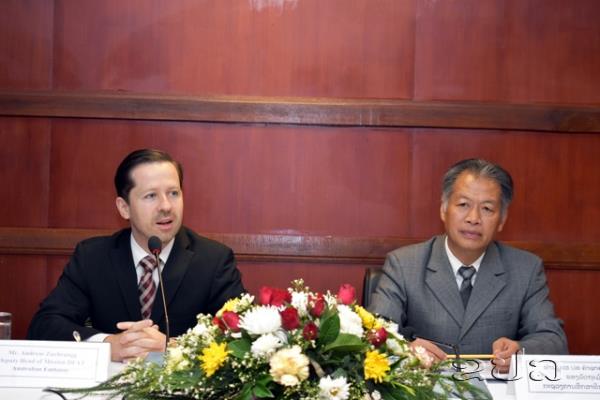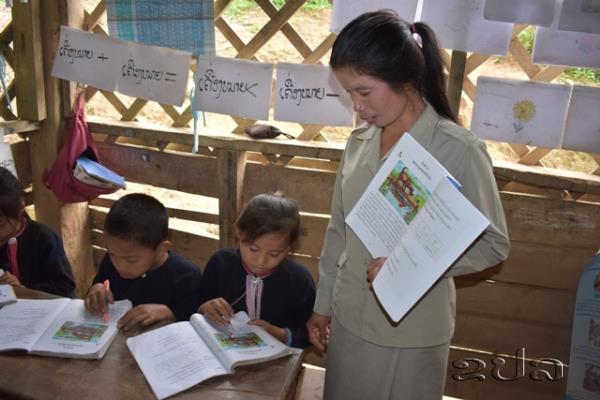KPL
(KPL) Since 2015, the Ministry of Education and Sports (MoES) has been in the process of revising the Lao PDR national primary curriculum, and developing new textbooks, teacher guides and other resources for the schools.

(KPL) Since 2015, the Ministry of Education and Sports (MoES) has been in the process of revising the Lao PDR national primary curriculum, and developing new textbooks, teacher guides and other resources for the schools.
On Wednesday, 23rd May, Assoc. Prof. Dr Khamphay Sisavanh, Vice Minister for Education and Sports and Mr Andreas Zurbrugg, Deputy Head of Mission, Australian Embassy chaired the Primary Curriculum Steering Committee Inaugural meeting to familiarise the different departments of MoES with the new primary curriculum, including key changes, teacher guides and teaching materials.
The meeting was held as a high level forum for discussion and the thirty-five participants were able to give their feedback on the proposed strategy for teacher in-service training for the curriculum roll-out.
The new primary curriculum will be rolled out gradually beginning with Grade 1 in September 2019.
It will be a national curriculum, every primary school in every district in every province of the Lao PDR will receive the revised teaching and learning materials.
There will be one textbook per student (more than 800,000 primary students). The new textbooks use colour and plenty of visuals, to increase attention and memory retention of the students.
In addition, all teachers will receive teacher guides for every subject taught (more than 35,000 primary school teachers).
The new teacher guides are more detailed and contain guidance on how to organise each lesson and suggestions for using local knowledge, creating extension activities, working with multi-grade classes or teaching non-Lao first language-speaking students.
Primary schools will receive a resource pack with educational materials, such as story books, reading books for beginners or flash cards to support the use of the revised curriculum.
All materials were tested in pilot schools around the country and improved with feedback from the trials.
Nine subjects will be taught in primary: Lao language, mathematics, science and environment (formerly “world around us”), morals, arts and handicraft, music, physical education, English from Grade 3 on and social studies from grade 4 on.
The new curriculum will be organized thematically. This new organisation is designed to increase integration and opportunities to revise key learning. The themes in each subject are taught at the same time in each grade, and this will help multigrade teachers with planning and delivery of lessons.
A special feature of the new curriculum is the orientation week. During the first week of school, all Grade 1 students will follow a programme of activities to help them feel familiar with school life and build their confidence in key routines, behaviours and skills needed in school.
This orientation week will help ensure children find school an interesting and enjoyable experience and is known to have a positive impact on learning outcomes.
With the objective to improve student learning outcomes, the development of the new curriculum was informed by child learning theory and established principles of effective primary school pedagogic practice.
Hence, one of the main changes with the new curriculum will be in the pedagogy approach. The new curriculum promotes active learning. The students will be engaged in the lessons by doing activities to encourage them to process new information and apply new knowledge learnt.
The teachers will be facilitators rather than one-way providers of information. Students will learn by doing meaningful learning activities and by reflecting about what they are doing.
“Today, we made acquaintance with the new primary curriculum development with related contents of teaching materials. Certainly, when we have new curriculum and instructional materials we want our teachers who are playing a key role in the implementation of curriculum at grassroot to be familiarised with both contents and methodology of teaching”, said Assoc. Prof. Dr. Khamphay Sisavanh.

“Developing a primary curriculum is the first step to improve student learning outcomes. But the second step, the development of good quality teacher training and support is essential to ensure that teachers can successfully implement the curriculum,” said Mr. Andreas Zurbrugg. “Australia, European Union and USAID are proud to be partnering with the Research Institute for Educational Sciences and Ministry of Education and Sports to support the development of the new curriculum and its roll out.”
Teacher training and support is essential to ensure that teachers can successfully implement the new curriculum. It is teachers who bring the curriculum to life in the classroom and they are crucial to the success of a curriculum innovation.
In-service teacher training modules will be developed based on the revised primary curriculum content and teaching methodology.
The roll out of the new curriculum is a huge task which will need the commitment and support of all stakeholders, from national, provincial, district and school levels. But the new national curriculum and associated teaching and learning resources will make an important contribution to the quality of the learning outcomes of children.
It will help more Lao girls and boys of primary school-age achieve functional literacy and numeracy and acquire life skills.
KPL